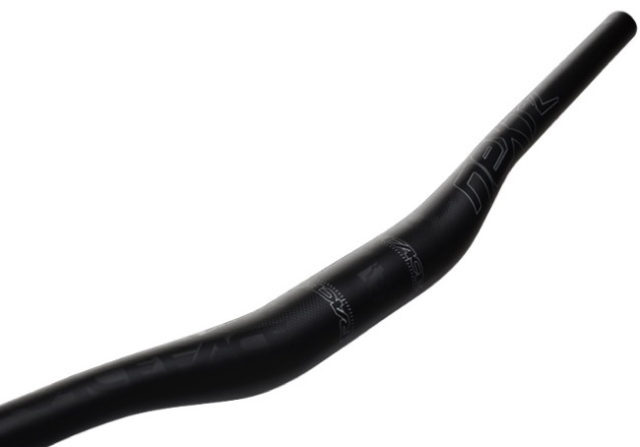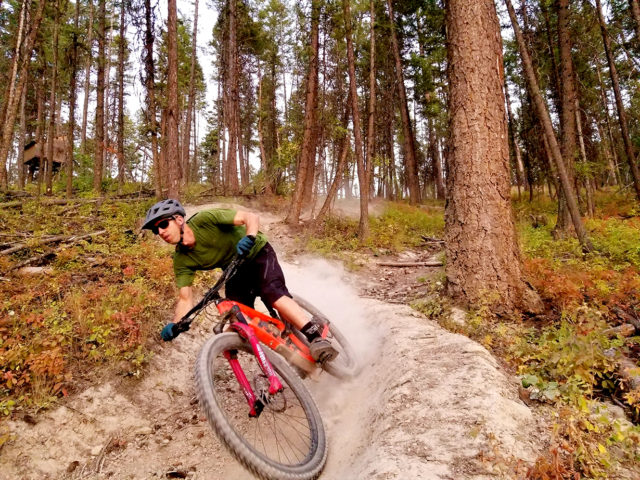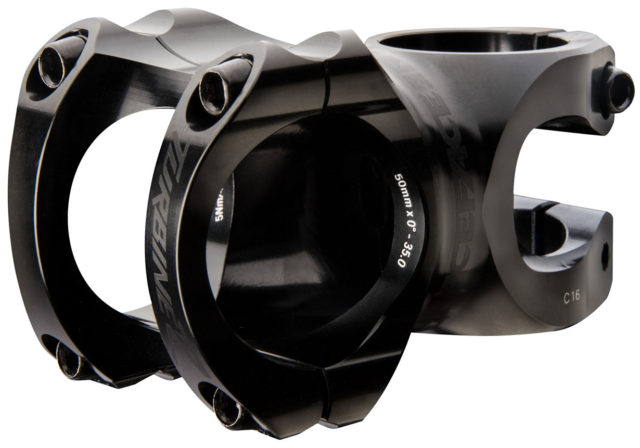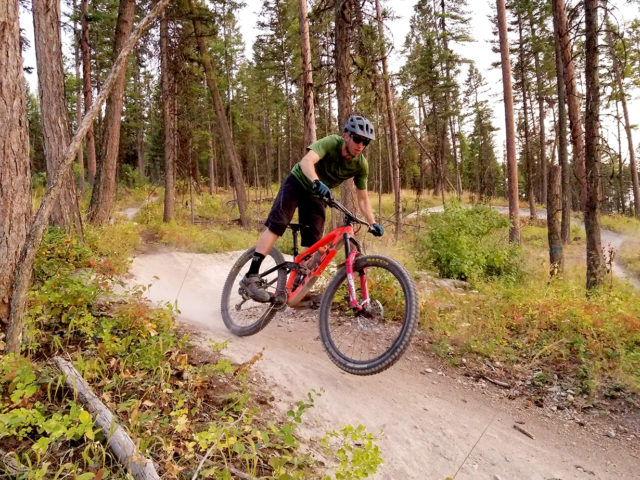
Race Face Next R Bar
Width: 800 mm
Clamp Size: 35 mm
Blister’s Measured Weight: 212 grams
Price: $169.99
Stated Features:
- Manufactured from UD Carbon with matte clearcoat.
- Carbon optimized flex for improved small bump compliance.
- 8°Back Sweep x 5° Up Sweep
Mounted to: Trek Slash
Reviewer: 5’9” 155 lbs
Test Location: Montana, British Columbia, and beyond!
Duration of Test: 2 months
Available Options, Features, and Specs
Race Face has been making nice carbon bars for a little while now, and I’ve become a big fan of their SixC bars — they’re decently light, they’re strong, and most importantly, they’re stiff but not too stiff. So when I was building up a bike to get Enduro-y on, I wanted a Race Face bar, and the Next R is situated as an Enduro-y sort of product, so it seemed like the logical choice.
Race Face offers up three carbon bar options — the Next SL, Next R, and SixC, and each one comes in an assortment of options. The Next SL is situated as the more XC / Trail oriented bar, and is narrower at 760 mm wide. The Next R is a bit burlier, and comes stock at 800 mm wide, and the SixC is the stoutest option, and also comes at 800 mm wide. Curiously, Race Face’s website lists the SixC as being lighter than the Next R, but on my scale, the Next R is lighter (although only by about 7 grams).
All of the carbon Race Face bars (and most of the aluminum ones as well) have the same 8° back / 5° up geometry. That’s fairly average among popular bars on the market — some are a little less swept, some are a little more swept. This is mostly a personal preference thing, but I tend to get along well with the 8° / 5° shape.
I rode the Next R bar with 20 mm rise, although it’s also offered with 10 and 35 mm rise. I also cut mine down to 780 mm, and hash marks towards the end of the bar make accurate trimming pretty easy.
The Ride
I’ve spent quite a bit of time on these bars (probably around 700 miles), riding everything from big backcountry loops to laps in the Whistler bike park. After all of that, everything about these bars falls right in line with my prior conclusions: I like how Race Face bars ride. They just hit a nice blend of stiffness for steering precision, while also doing a decent job of damping out vibrations to help keep my hands from hurting.

I’ve ridden a number of 35 mm bars (and some 31.8 mm bars) that were just too damn stiff. While they feel great when forcing the bike into a deep corner, my hands and forearms would be shredded after a long day on the bike. This isn’t to say that a bell-to-bell day on the Next R’s at the Whistler bike park doesn’t still leave my hands sore, but relatively speaking, they’re pretty good.
I’ve also taken a bunch of crashes on the Next R’s. I’ve clipped my bars on rocks at high speeds, I’ve had quite a few crashes that resulted in the bars twisting, and on a couple occasions, I’ve sent the bike tomahawking down the hill. Throughout all of that, the Next R bars are looking perfectly fine. There’s a bit of minor cosmetic scuffing, but nothing that makes me question whether I should stop riding them. That all could just be dumb luck, but based on my time on them (and my time crashing them), they seem to hold up quite well.
Bottom Line
I’ve been a fan of Race Face bars, and after spending a lot of time riding on the Next R bars, I’m still a big fan. They’re light, I like the shape, I think they’re well made, but most of all, I think they ride really well. The Next R sits in the middle of Race Face’s carbon bar lineup, which happens to mean they’re perfect for what I’m looking for. They have the width of a DH bar, but come in just a smidge lighter (which probably also means they’re not quite as stiff, although I’m pretty sure I can’t tell the difference). If I was building an XC rig, I’d go with the Next — they’re significantly lighter. If I was building a DH bike, I’d probably stick with the aluminum Atlas 35 bars — those things get banged around and scuffed up on shuttle rigs, and carbon makes me nervous in that situation. But for everything in between, the Next R is the ticket for me.

Race Face Turbine R Stem
Length: 40 mm
Clamp Size: 35 mm
Blister’s Measured Weight: 130 grams
Price: $104.99
Features:
- 0° Rise.
- Ø35mm handlebar clamp
Features, Specs, and Ease of Use
I’m not going to act like I can tell a difference in how most stems ride — for me, picking a stem mostly comes down to what features it has, so I’ll keep this pretty brief.
The Turbine R stem comes in a bunch of different lengths. The shortest is 32 mm, which is the shortest you can go with a 35 mm bar unless you start doing weird things to put the bar above the steerer tube. The longest length is 70 mm, and it’s offered in 10 mm increments in between. All the stems feature the same 0° rise.

There are three relatively minor features that make me like this stem:
- First, all bolts require a 4 mm hex wrench. That’s easy, and I feel like 5 mm bolts are unnecessarily large, while 3 mm bolts are too small (listen up, Thompson!).
- Second, it has a one-piece faceplate, which just makes things easier.
- Third, Race Face’s Toplock faceplate is a good idea. Tighten the top two bolts all the way, so the faceplate is snugged against the stem. Then torque the bottom two bolts. This makes it easier to get even torque and even pressure across the faceplate, which matters with carbon bars.
Bottom Line
The Turbine R does what a good stem should do, which is not let the bar slip, not have any angular protrusions that I’m going to hit my knee on, and in pretty much all other respects, avoid calling attention to itself. It’s a well thought out piece of componentry, and the machining on it is nice to look at. I don’t really have anything to complain about, which is noteworthy in and of itself. The Turbine R is a solid choice, it’s decently light, and it works. Enough said.

Great summary! I just ordered a Next R w/ 35 mm rise. I don’t do any enduro just rocky trail. I’ll cut the don to 780mm.